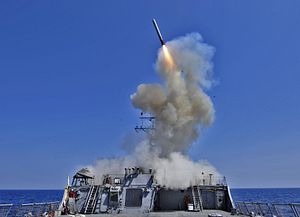The U.S. Army is getting into the anti-ship cruise missile business. The service has contracted to equip mobile launchers with either the Tomahawk long-range cruise missile or the SM-6 “Standard” missile for use in attacks against ships at sea. While the project has been in the works for some time, the decision to move forward indicates that the Army is serious about making a contribution in the Pacific. The Army’s longest ranged missiles can now strike targets up to 300 kilometers away, a range which will be expanded to at least 500 km by the introduction of new missiles beginning in 2023.
The turn toward ground-based anti-ship missiles is understandable. Experience during World War II and thereafter demonstrated the complexity of destroying even stationary fortified gun emplacements, and while ships and planes are mobile they are also vulnerable. Stephen Trimble provided some context for the Army’s decision, which has included an institutional rethink of how to contribute to the joint fight. As Trimble notes, the Army and the U.S. Marine Corps need more than just shooters; they need sensors to identify and track ships at sea. The Army has spearheaded Project Convergence, which seeks to integrate sensor data into a single decision-making system that will enable target acquisition.
The long-range cruise missiles represent only one component of the Army’s contribution in the Pacific. For example, the Army has equipped the latest versions of its AH-64 Apache helicopters with the capability to identify, track, and target naval targets with anti-surface missiles. This tracks with practice in the French and Russian navies, which have long contemplated the use of helicopters as missile platforms. The Army’s Strategic Long Range Cannon may or may not ever enter service, but if it does it would offer a potent weapon against both ships and land-based targets.
Notwithstanding the Army’s efforts in this regard, competition with China may require a fundamental rethinking of how the U.S. Department of Defense has allocated its procurement dollars over the past 60 years. This has resulted in a surprisingly robust pattern of spending in which the three services have stable budgets relative to one another, despite often profound changes in the strategic threat environment and in the technological toolbox. Whether the Army can assert its claim to its traditional share of that pie through the means of anti-ship missiles remains in some doubt. There is no central front in the Pacific, and consequently no Fulda Gap to give the Army an operational focus. The Marine Corps, also at something of a loss in the Pacific, has also worked to develop munitions for use in attacks on ships. The Marine Corps also benefits from a tighter relationship with the U.S. Navy, including the use of compatible combat and communications systems.
Still, the steps taken thus far represent a solid opening bid for the Army. The role it plays in the future of U.S.-China competition may not involve high-intensity armored maneuver combat, but the service can still bend its doctrine and organizational wherewithal toward missions and technologies that can support the military effort in the Pacific. The prospect of Army helicopters launching anti-ship missiles against targets identified by drones, satellites, and submarines should certainly worry any Chinese naval planner. And of course there are still some envisionable missions that would require the Army to engage in maneuver warfare against a peer foe, whether on Taiwan in the case of an amphibious invasion or the Korean peninsula in case of conflict with Pyongyang.

































